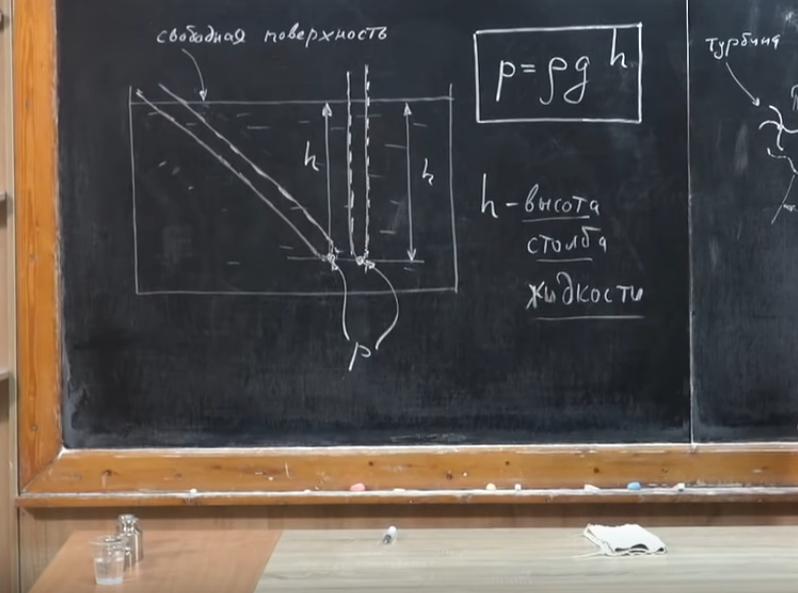Since gravity acts on a liquid, the liquid substance has weight. Weight is the force with which it presses on a support, i.e., on the bottom of the vessel into which it is poured. Pascal's law says: pressure on a fluid is transmitted to any point on it, without changing its strength. How to calculate the pressure of the liquid on the bottom and walls of the vessel? We will understand the article using illustrative examples.
Experience
Imagine that we have a cylindrical vessel into which a liquid is poured. We denote the height of the liquid layer h, the bottom area of the vessel is S, and the density of the liquid is ρ. The desired pressure is P. It is calculated by dividing the force acting at an angle of 90 ° to the surface by the area of this surface. In our case, the surface is the bottom of the tank. P = F / S.

The force of fluid pressure at the bottom of a vessel is weight. It is equal to the force of pressure. Our liquid is motionless, therefore, the weight is equal to the force of gravity (F heavy ) acting on the liquid, and hence the pressure force (F = F heavy ). F strand is found as follows: multiply the mass of liquid (m) by the acceleration of gravity (g). A mass can be found if it is known what is the density of the liquid and what is its volume in the vessel. m = ρ × V. The vessel has a cylindrical shape, so we will find its volume by multiplying the area of the base of the cylinder by the height of the liquid layer (V = S × h).
Calculation of fluid pressure at the bottom of the vessel
Here are the quantities we can calculate: V = S × h; m = ρ × V; F = m × g. We substitute them into the first formula and get the expression: P = ρ × S × h × g / S. Reduce the area S in the numerator and denominator. It will disappear from the formula, which means that the pressure on the bottom does not depend on the area of the vessel. In addition, it does not depend on the shape of the container.
The pressure that the liquid creates on the bottom of the vessel is called hydrostatic. “Hydro” is “water,” and static is because the fluid is motionless. Using the formula obtained after all the transformations (P = ρ × h × g), determine the fluid pressure at the bottom of the vessel. It can be seen from the expression that the denser the liquid, the greater its pressure on the bottom of the vessel. Let us examine in more detail what constitutes the value of h.
Fluid pressure
Suppose we have increased the vessel from below by a certain amount, added additional space for the liquid. If we put a fish in the tank, the pressure on it will be the same in the vessel from the previous experiment and in the second, increased? Will the pressure change because there is still water under the fish? No, because there is a certain layer of liquid on top, gravity acts on it, which means that water has weight. And that from below does not matter. Therefore, we can find the pressure in the very thickness of the liquid, and h - this will be the depth. It is not necessarily the distance to the bottom, the bottom may be lower.

Imagine that we turned the fish 90 °, leaving it at the same depth. Will the pressure on her change from this? No, because at depth it is the same in all directions. If we bring the fish closer to the vessel wall, will the pressure on it change if it remains at the same depth? No. In all cases, the pressure at depth h will be calculated using the same formula. This formula means that it is possible to find the pressure of the liquid at the bottom and the walls of the vessel at a depth h, i.e., in the thickness of the liquid. The deeper, the bigger it is.
Inclined Vessel Pressure
Imagine that we have a tube about 1 m long. We poured liquid into it so that it is completely filled. Take the exact same tube, filled to the brim, and place it at an angle. The vessels are the same and filled with the same fluid. Therefore, the mass and weight of the liquid in both the first and second tubes are equal. Will the pressure at the points located at the bottom of these tanks be the same? At first glance, it seems that the pressure P 1 is equal to P 2 , since the mass of liquids is the same. Suppose this is so, and conduct an experiment to verify.
Connect the lower parts of these tubes with a small tube. If our assumption that P 1 = P 2 is correct, will the fluid flow somewhere? No, because forces of the opposite direction will act on its particles, which will compensate each other.
Let's attach a funnel to the inclined tube on top. And on the vertical tube we’ll make a hole, insert a tube into it, which bends down. The pressure at the hole level is greater than at the very top. So, the liquid will flow over a thin tube and fill the funnel. The mass of liquid in the inclined tube will increase, the fluid will flow from the left tube to the right, then it will rise and circulate in a circle.
And now we’ll install a turbine over the funnel, which we will connect with an electric generator. Then this system will independently generate electricity without any intervention. She will work without stopping. It would seem that this is the "perpetual motion machine." However, back in the 19th century, the French Academy of Sciences refused to accept any such projects. The law of conservation of energy suggests that it is impossible to create a “perpetual motion machine”. Therefore, our assumption that P 1 = P 2 is false. In fact, P 1 <P 2 . How then to calculate the pressure of the liquid at the bottom and the walls of the vessel in the tube, which is located at an angle?
Fluid Height and Pressure
To find out, let us conduct the following thought experiment. Take a vessel filled with liquid. We put in it two tubes of metal mesh. We will arrange one vertically and the other obliquely, so that its lower end will be at the same depth as the bottom of the first tube. Since the containers are at the same depth h, the pressure of the liquid on the bottom and the walls of the vessel will also be the same.

Now close up all the holes in the tubes. Due to the fact that they have become continuous, the pressure in their lower parts will change? No. Although the pressure is the same and the vessels are equal in size, the mass of liquid in the vertical tube is less. The depth at which the bottom of the tube is located is called the height of the liquid column. Let us define this concept: this is the vertical distance measured from the free surface to a given point in the liquid. In our example, the height of the liquid column is the same, so the pressure is the same. In a previous experiment, the height of the liquid column in the right tube is greater than in the left. Therefore, the pressure P 1 is less than P 2 .